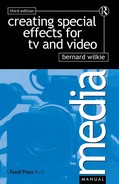Models and Miniatures
Another method of counterfeiting a scene is to use a model – a technique as old as movie-making itself.
Employed in this fashion the model is called a miniature. When designed to be only part of a scene it is referred to as a hanging miniature.
In its most elementary form a miniature could be a model landscape, a building or even a single window in the wall of a house.
The advantage of employing a miniature is that it can be more economic than building scenery or finding a suitable location. Furthermore an exterior model erected and recorded indoors will be unaffected by weather.
Static shots
An ancillary set in the studio of, say, the end wall of a ballroom would be transformed if it were to be augmented with two side walls. Scale models of these positioned in front of the set would give the effect of a three-sided room. Even if the sequence were to involve nothing more than a servant entering and lighting some candles, the small amount of model-making effort would give the set a breadth and depth out of all proportion to the space it occupied in the studio.
Another example might feature the hold of a cargo ship in which someone had to examine its contents. To fill a TV studio with dozens of packing cases would be impractical, and so a sequence employing a hanging miniature in front of the camera and a few life-sized crates on the floor could be devised.
Where sequences call for inter-cutting between the set and the miniature it is important to ensure that the models do not attempt to replicate their full-sized counterparts – the differences in texture and finish will be quite apparent. In this case, the hold of a ship, presumably containing many different objects, would enable any disparity to be disguised.
Shots with action
The above examples illustrate the use of static models, but miniatures are often designed to include some form of animation. A flashing lighthouse or a distant building in which a window lights up are among the simplest. But where more complicated scenes include working parts or moving machinery it could be less costly to build a model than to construct a full sized set.
MODEL SHOTS
1. Models to set the scene
Three dimensional models are often used to establish a scene, and in some cases they may have to be very detailed.
2. Part-model construction
It is sometimes simpler to use a photograph with only part of the model built in three dimensions. This is particularly useful if some action has to take place on what would otherwise be a complicated model.

